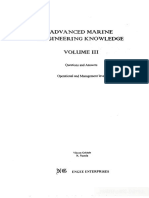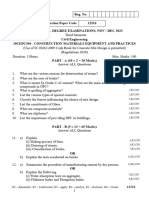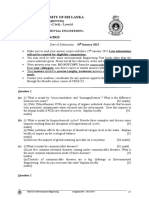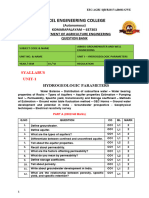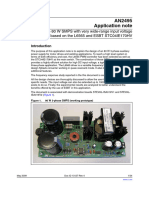0 ratings0% found this document useful (0 votes)
9 viewsWs&wwe Iat 2 (Set 1)
Ws&wwe Iat 2 (Set 1)
Uploaded by
sivabalanCopyright:
© All Rights Reserved
Available Formats
Download as PDF, TXT or read online from Scribd
Ws&wwe Iat 2 (Set 1)
Ws&wwe Iat 2 (Set 1)
Uploaded by
sivabalan0 ratings0% found this document useful (0 votes)
9 views2 pagesOriginal Title
WS&WWE IAT 2 (SET 1)
Copyright
© © All Rights Reserved
Available Formats
PDF, TXT or read online from Scribd
Share this document
Did you find this document useful?
Is this content inappropriate?
Copyright:
© All Rights Reserved
Available Formats
Download as PDF, TXT or read online from Scribd
Download as pdf or txt
0 ratings0% found this document useful (0 votes)
9 views2 pagesWs&wwe Iat 2 (Set 1)
Ws&wwe Iat 2 (Set 1)
Uploaded by
sivabalanCopyright:
© All Rights Reserved
Available Formats
Download as PDF, TXT or read online from Scribd
Download as pdf or txt
You are on page 1of 2
Reg No:
QUESTION PAPER CODE: JP3033
B.E / B. Tech. DEGREE EXAMINATIONS, SEP 2024
Third Semester
CIVIL ENGINEERING
CE3303 – WATER SUPPLY AND WASTEWATER ENGINEERING
Internal Assessment Test – I
(Regulation 2021)
Time: 3 Hours Maximum: 100 Marks
Answer ALL questions
PART A - (10 X 02 = 20 Marks)
1. What is meant by potable water? CO1 [K1]
2. Classify the various sources of water. CO1 [K2]
3. Define ‘Per Capita Demand’. CO1 [K1]
4. Recall the term ‘Design period’ in water supply project. CO1 [K1]
5. Show any four types of chlorination CO2 [K2]
6. Define deflouridation CO2 [K1]
7. Illustrate, how do you remove iron and manganese from water? CO2 [K2]
8. What do you mean by water softening? CO2 [K1]
9. How can you calculate the service capacity of the reservoir CO3 [K1]
10. Summarize the requirements of water distribution system. CO3 [K2]
PART B – (05 X 13 = 65 Marks)
11(a) Explain the river intake and canal intake structures with neat diagram and CO1 [K2] (13)
mention the factors governing the location of intake structures.
(OR)
th
(b) Illustrate the water requirement at the 60 year for a city having growth following CO1 [K2] (13)
logistic curve with the following data. Population at t=0 year is 35000, population
at the 20th year = 180000, Population at the 40th year is = 340000. Assume per
capita water requirements as per CPHEEO standards.
12(a) Develop the Common physical and chemical test that should be carried out in the CO1 [K3] (13)
examination of water and explain their significance.
(OR)
(b) The population for five decade from 1970 to 2010 are given below. Identify the CO1 [K3] (13)
population after one, two and three decades beyond the last known decade by
using geometric increase method.
Year 1970 1980 1990 2000 2010
Population 25000 28000 34000 42000 47000
13(a) Sketch and explain Zeolite process for the removal of permanent hardness from CO2 [K2] (13)
water.
(OR)
(b) Compare and contrast the slow sand filter and rapid sand filter with suitable CO2 [K2] (13)
diagram.
14(a) Construct a clariflocculator for a population of 60000 persons. Per-capita demand CO2 [K3] (13)
is 150 LPCD. Peak demand 180% of average demand. Assume suitable data if
necessary.
(OR)
(b) Explain the various methods of removing excess iron and manganese from ground CO2 [K2] (13)
water.
15(a) Apply the flow in each pipe in the loop shown in figure. Use hardy cross method CO3 [K3] (13)
for analyzing the loop. Consider CH as 100 for all pipes.
(OR)
(b) List the various types of reservoirs with its function. CO3 [K4] (13)
PART C – (01 X 15 = 15 Marks)
16(a) i) Classify and describe the factors affecting the rate of water demand CO1 [K2] (07)
ii) Design a rectangular sedimentation tank to treat 3 million liters of water per CO2 [K3] (08)
day. Adopt surface over flow rate as 24000 L/day/m2, detention time as 4 hours
and length to width ratio as 3:1
(OR)
(b) i) Illustrate water borne diseases CO1 [K2] (08)
ii) Distinguish between coagulation aided sedimentation and plain sedimentation CO2 [K3] (07)
Knowledge Level:
[K1] - Remember, [K2] - Understand, [K3] – Apply, [K4] – Analyze, [K5] – Evaluate & [K6] - Create
CO Course Outcomes Level
CO1 : Understand the various components of water supply scheme and design of intake structure
K2
and conveyance system for water transmission.
CO2 : Understand on the characteristics and composition of sewage, ability to estimate sewage
K2
generation and design sewer system including sewage pumping stations.
CO3 : Understand the process of conventional treatment and design of water and waste water
treatment system and gain knowledge of selection of treatment process and biological K2
treatment process
CO4 : Ability to design and evaluate water distribution system and water supply in buildings and
K3
understand the self-purification of streams and sludge and septic disposal methods
CO5 : Able to understand and design various advanced treatment system and knowledge about
K2
the recent advances in water and waste water treatment process and reuse of sewage.
Faculty In-charge HOD
You might also like
- CHEM PP2 KCSE 2024 PREDICTION TRIALS With AnswersDocument132 pagesCHEM PP2 KCSE 2024 PREDICTION TRIALS With AnswersMusa Leiyagu100% (1)
- Advanced Marine Engineering Knowledge - Volume III (Vikram Gokhale - N. Nanda)Document248 pagesAdvanced Marine Engineering Knowledge - Volume III (Vikram Gokhale - N. Nanda)Anshu BhushanNo ratings yet
- Geometry Chapter 1 WorksheetsDocument7 pagesGeometry Chapter 1 Worksheetsapi-306720213100% (2)
- Qp Model Exam Set2_oen 351 - DwstDocument2 pagesQp Model Exam Set2_oen 351 - Dwstsabarisriram.v.cse2021No ratings yet
- CVR College of Engineering: UGC Autonomous InstitutionDocument2 pagesCVR College of Engineering: UGC Autonomous InstitutionCh VenkateshNo ratings yet
- CVR College of Engineering: UGC Autonomous InstitutionDocument2 pagesCVR College of Engineering: UGC Autonomous InstitutionCh VenkateshNo ratings yet
- Cos After The Completion of This Course, Students Will Be Able ToDocument2 pagesCos After The Completion of This Course, Students Will Be Able ToHarshit Singh YadavNo ratings yet
- Ee TutorialsDocument11 pagesEe Tutorialsbrillianthp15No ratings yet
- CVR College of Engineering: UGC Autonomous Institution - Affiliated To JNTUHDocument2 pagesCVR College of Engineering: UGC Autonomous Institution - Affiliated To JNTUHCh VenkateshNo ratings yet
- Ee TutorialsDocument9 pagesEe TutorialsKush PatelNo ratings yet
- 1151ce304 EilDocument2 pages1151ce304 EilravindrasskNo ratings yet
- BCV304Document2 pagesBCV304nagesh31190m mustapureNo ratings yet
- Sanjay Ghodawat University, Kolhapur: InstructionsDocument2 pagesSanjay Ghodawat University, Kolhapur: InstructionsAmey KatdareNo ratings yet
- HYDROLOGY & WATER RESOURCES SyllabusDocument12 pagesHYDROLOGY & WATER RESOURCES SyllabusHarikrishna SNo ratings yet
- BE - CIVIL - Drinking Water & Sanitary Engineering - Dec 2019Document3 pagesBE - CIVIL - Drinking Water & Sanitary Engineering - Dec 2019SAURAV BHENDENo ratings yet
- SUSTAINABLE WATER RESOURCES DEVELOPMENTDocument1 pageSUSTAINABLE WATER RESOURCES DEVELOPMENTganeshkumarkataNo ratings yet
- CET 307 SyllabusDocument12 pagesCET 307 SyllabusdipinnediyaparambathNo ratings yet
- Bfc32403 Environmental EngineeringDocument4 pagesBfc32403 Environmental Engineeringznyaphotmail.comNo ratings yet
- BFC32403 Environmental EngineeringDocument4 pagesBFC32403 Environmental EngineeringAlisa NaziraNo ratings yet
- University of Zimbabwe: Water and Public Health Engineering February 2009 Engin. CE 408Document6 pagesUniversity of Zimbabwe: Water and Public Health Engineering February 2009 Engin. CE 408kundayi shavaNo ratings yet
- AssignmentsDocument2 pagesAssignmentsNilesh NagoseNo ratings yet
- Test 2 QP CIV 212 (Environmental Engineering)Document4 pagesTest 2 QP CIV 212 (Environmental Engineering)SanthoshMBSanthuNo ratings yet
- 05. CEE 4431 Water Supply EngineeringDocument5 pages05. CEE 4431 Water Supply EngineeringMuhtasib Jamil RaiyanNo ratings yet
- Jss Academy of Technical Education, Noida Department of Civil EngineeringDocument1 pageJss Academy of Technical Education, Noida Department of Civil EngineeringHarshit Singh YadavNo ratings yet
- Copy-of-20CEPC304-CONSTRUCTION-MATERIALS-EQUIPMENT-AND-PRACTICES-1 (1)Document2 pagesCopy-of-20CEPC304-CONSTRUCTION-MATERIALS-EQUIPMENT-AND-PRACTICES-1 (1)periyasamysivakumar26No ratings yet
- Environmental Engineering 4Document1 pageEnvironmental Engineering 4kabirdhivarNo ratings yet
- Chapter 7 EPC - Water Pollution011 - ModifiedDocument43 pagesChapter 7 EPC - Water Pollution011 - Modifiedsandeep malavNo ratings yet
- Option E Past Paper QuestionsDocument6 pagesOption E Past Paper QuestionsmafooooooooooNo ratings yet
- Berm VDocument2 pagesBerm VInnocentvishwaNo ratings yet
- University of Zimbabwe B.Sc. (Engineering) Honours - Level IVDocument8 pagesUniversity of Zimbabwe B.Sc. (Engineering) Honours - Level IVkundayi shavaNo ratings yet
- Model Exam - AEIDocument2 pagesModel Exam - AEIA V S COLLEGE OF TECHNOLOGYNo ratings yet
- Public Health Engineering (Supp) - Ece 2305Document2 pagesPublic Health Engineering (Supp) - Ece 2305Murtatha100% (1)
- Ce408 2010 08Document5 pagesCe408 2010 08Daryl ChidengaNo ratings yet
- Environment Assignment Mid Term II 2022Document1 pageEnvironment Assignment Mid Term II 2022Vivek SainiNo ratings yet
- Question Paper Code:: CO1: CO2: CO3: CO4: CO5Document3 pagesQuestion Paper Code:: CO1: CO2: CO3: CO4: CO5yaro oruvan100% (1)
- UntitledDocument27 pagesUntitledPrerana TvNo ratings yet
- Important Question Environmental EngineeringDocument3 pagesImportant Question Environmental Engineeringsomesh dubeyNo ratings yet
- 2003 CaCO3-Panthi-2003Document16 pages2003 CaCO3-Panthi-2003Izzat W. KaziNo ratings yet
- Engineer Written Paper 2080 - KARNALIDocument2 pagesEngineer Written Paper 2080 - KARNALIKSHITIJANo ratings yet
- SSN College of Engineering, Kalavakkam - 603 110Document2 pagesSSN College of Engineering, Kalavakkam - 603 110Eshanth RajNo ratings yet
- Waste Wate 19Document3 pagesWaste Wate 19anonymousNo ratings yet
- Jss Academy of Technical Education, Noida Department of Civil EngineeringDocument1 pageJss Academy of Technical Education, Noida Department of Civil EngineeringHarshit Singh YadavNo ratings yet
- Model Exam AHE PDFDocument5 pagesModel Exam AHE PDFmaran2326No ratings yet
- Akt Memorial College of Engineering and Technology B.E, Model Exam, October-2017 Fifth Semester, (Regulation 2013) Ce 6503 - Environmental Engineering-IDocument2 pagesAkt Memorial College of Engineering and Technology B.E, Model Exam, October-2017 Fifth Semester, (Regulation 2013) Ce 6503 - Environmental Engineering-IManikandan SelvamNo ratings yet
- Waste Water Management (CIE 2254) RCS (Makeup)Document2 pagesWaste Water Management (CIE 2254) RCS (Makeup)anshikaNo ratings yet
- Ramesh 2020 - Carbonation-Induced Corrosion A Brief Review On PredictionDocument11 pagesRamesh 2020 - Carbonation-Induced Corrosion A Brief Review On PredictionSuhail BabaNo ratings yet
- PHE 22504 SolutionDocument6 pagesPHE 22504 Solution222raj3007No ratings yet
- Assignment 2 - CE 308Document1 pageAssignment 2 - CE 308CE089Shoubhik DasNo ratings yet
- 8th Sem QP Bank For 2 IADocument2 pages8th Sem QP Bank For 2 IAPraveen Kumar K MENo ratings yet
- The Openuniversity of Sri Lanka: Department of Civil Engineering Bachelor of Technology (Civil) - Level 6Document4 pagesThe Openuniversity of Sri Lanka: Department of Civil Engineering Bachelor of Technology (Civil) - Level 6kz_kamranNo ratings yet
- Energy and Environment MQPDocument4 pagesEnergy and Environment MQPLokesh RawalNo ratings yet
- Gwe Unit - 1 QB-1Document2 pagesGwe Unit - 1 QB-1keerthanaamsavel15No ratings yet
- rr310104 Environmental Engineering IDocument8 pagesrr310104 Environmental Engineering ISRINIVASA RAO GANTANo ratings yet
- TY BTech CH Process Engineering SEM-V Jun 2022Document2 pagesTY BTech CH Process Engineering SEM-V Jun 2022Mule Avishkar DattatrayNo ratings yet
- 2Document2 pages2sabarisriram.v.cse2021No ratings yet
- Ce3391 FMM Mech ModelDocument5 pagesCe3391 FMM Mech ModelVivekananda SubramaniNo ratings yet
- Course Code: CET 402 Gths/Rs - 19 / 7025 Seventh Semester B. E. (Civil Engineering) ExaminationDocument3 pagesCourse Code: CET 402 Gths/Rs - 19 / 7025 Seventh Semester B. E. (Civil Engineering) ExaminationanonymousNo ratings yet
- (Sem. Vi) Theory Examination 2013-14: PAPER ID: 100658Document2 pages(Sem. Vi) Theory Examination 2013-14: PAPER ID: 100658AkhaleshNo ratings yet
- EA4527s2017 18Document10 pagesEA4527s2017 18scrawnyoutlineNo ratings yet
- Durability Design of Concrete Structures: Phenomena, Modeling, and PracticeFrom EverandDurability Design of Concrete Structures: Phenomena, Modeling, and PracticeNo ratings yet
- Hydrodynamics and Water Quality: Modeling Rivers, Lakes, and EstuariesFrom EverandHydrodynamics and Water Quality: Modeling Rivers, Lakes, and EstuariesNo ratings yet
- BotanyDocument10 pagesBotanymeashishswami2006No ratings yet
- Exercise 3D: 1 Key: 1 - 2 Means 12 Movies 0 1 2 3 4Document3 pagesExercise 3D: 1 Key: 1 - 2 Means 12 Movies 0 1 2 3 4ahmed ramadanNo ratings yet
- Ancient Greek PhilosophersDocument50 pagesAncient Greek PhilosophersJor Garcia100% (1)
- SuperNova Solutions - Company ProfileDocument13 pagesSuperNova Solutions - Company ProfileNoman AhmedNo ratings yet
- Excel Business Math Video 42 Simple InterestDocument47 pagesExcel Business Math Video 42 Simple InterestJun Clifford AngelesNo ratings yet
- Project 2Document2 pagesProject 2api-345897826No ratings yet
- Joining: Dept. of Computer Science Faculty of Science and TechnologyDocument17 pagesJoining: Dept. of Computer Science Faculty of Science and TechnologyMaruf ShahriarNo ratings yet
- Öğrenci̇ SözlüğüDocument122 pagesÖğrenci̇ SözlüğüK M Mosheur RahmanNo ratings yet
- Advanced Programming and Design For Your Small Machine: Hands-On LabDocument23 pagesAdvanced Programming and Design For Your Small Machine: Hands-On LabBruno SamosNo ratings yet
- Design 2 1 PDFDocument255 pagesDesign 2 1 PDFAjayNo ratings yet
- Sensor Basics Tutorial NIDocument9 pagesSensor Basics Tutorial NImaxellligue5487No ratings yet
- Exploratory Data Analytics With SQLDocument27 pagesExploratory Data Analytics With SQLHoney BeeNo ratings yet
- Namma Kalvi 11th Maths 4 Chapters 1 Mark Question Paper emDocument15 pagesNamma Kalvi 11th Maths 4 Chapters 1 Mark Question Paper emsanjusenthil8No ratings yet
- What Is A Frequent Itemset?Document7 pagesWhat Is A Frequent Itemset?ysakhare69No ratings yet
- Impact of Fintech Adoption On Select Macroeconomic Variables in India: An ARDL ApproachDocument25 pagesImpact of Fintech Adoption On Select Macroeconomic Variables in India: An ARDL Approachcerohad333No ratings yet
- Particle in A Box (Text 5.8) : Boundary ConditionsDocument7 pagesParticle in A Box (Text 5.8) : Boundary ConditionsRakib AhsanNo ratings yet
- Omnidirectional Base Station SolutionsDocument12 pagesOmnidirectional Base Station SolutionsAlejandro MascorroNo ratings yet
- TG-25.13-11-Rev 1Document14 pagesTG-25.13-11-Rev 1Haries Bugarin GarciaNo ratings yet
- Prediction and Design of Mechanical Properties of Origami-Inspired Braces Based On Machine LearningDocument21 pagesPrediction and Design of Mechanical Properties of Origami-Inspired Braces Based On Machine LearningAnh NguyễnNo ratings yet
- Download full The Radio Amateur s Hand Book 15th revised Edition A. Frederick Collins ebook all chaptersDocument75 pagesDownload full The Radio Amateur s Hand Book 15th revised Edition A. Frederick Collins ebook all chaptersstxnerdanden100% (5)
- 125SPC 2425116IOM - 53 - Thermatile - Plus - Issue - 4Document12 pages125SPC 2425116IOM - 53 - Thermatile - Plus - Issue - 4PeterNo ratings yet
- MLT Unit 5 PartbDocument19 pagesMLT Unit 5 Partbhimuna2102No ratings yet
- Karous-Hjelt ManualDocument19 pagesKarous-Hjelt ManualRhama DiantoNo ratings yet
- Strength of Materials LabDocument30 pagesStrength of Materials LabDipesh GugaleNo ratings yet
- Astm D5444Document3 pagesAstm D5444karenmerino94100% (1)
- Humidity Conversion Formulas B210973EN-F PDFDocument17 pagesHumidity Conversion Formulas B210973EN-F PDFGyana MatiNo ratings yet
- AN 2495 - STEVAL-ISA019v2Document34 pagesAN 2495 - STEVAL-ISA019v2orkun burkayNo ratings yet
- Dobot Magician V2 User Guide (DobotLab-based) V2.3.1Document119 pagesDobot Magician V2 User Guide (DobotLab-based) V2.3.1Minhajul Qowim1No ratings yet

